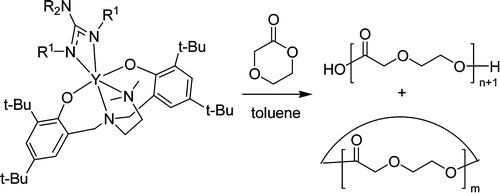Dongmei Cui‡
†Key Laboratory of Organic Synthesis of Jiangsu Province and Suzhou Key Laboratory of Macromolecular Design and Precision Synthesis, College of Chemistry, Chemical Engineering and Materials Science, Dushu Lake Campus, Soochow University, Suzhou 215123, People's Republic of China
‡State Key Laboratory of Polymer Physics and Chemistry, Changchun Institute of Applied Chemistry, Chinese Academy of Sciences, Changchun 130022, People's Republic of China
§Organometallic Chemistry Laboratory, Ningbo Institute of Technology, Zhejiang University, Ningbo 315100, People's Republic of China
Organometallics 2014, 33, 6803–6811
A series of neutral yttrium guanidinates supported by an amine-bridged bis(phenolate) ligand were synthesized, and their catalytic behaviors for the ring-opening polymerization of 1,4-dioxan-2-one (p-dioxanone, PDO) were explored. Metathesis reactions of amine-bridged bis(phenolate) yttrium chlorides LLnCl(THF) [L = Me2NCH2CH2N{CH2-(2-OC6H2-tBu2-3,5)}2] with corresponding lithium guanidinates generated in situ in a 1:1 molar ratio in THF gave the neutral yttrium guanidinates LY[R2NC(NR1)2] [R1 = −Cy, R2N = −N(TMS)2 (1), −NiPr2 (2), −N(CH2)5 (3); R1 = −iPr, R2N = −NiPr2 (4) −NPh2 (5))]. These complexes were well characterized by elemental analyses, IR, and NMR spectroscopy. The definitive molecular structures of these complexes were determined by single-crystal X-ray analysis. It was found that these complexes can efficiently initiate the ring-opening polymerization (ROP) of PDO, and the catalytic activity is affected by the nature of the guanidinate groups with the active sequence of 1 > 2 ≈ 3 ≈ 4 > 5. The influences of reaction conditions such as polymerization time, polymerization temperature, and molar ratio of monomer to initiator on the polymerization were also investigated. The polymerization kinetics of PDO catalyzed by complex 1 is first-order with respect to monomer concentration, and the apparent activation energy amounts to 30.8 kJ mol-1. The mechanistic investigations showed that the ROP of PDO proceeded through a coordination–insertion mechanism with a rupture of the acyl–oxygen bond of the monomer. MALDI-TOF mass spectrum analysis of the oligomer revealed that there are two kinds of polymer chains in this catalytic system, e.g., the linear chains H–[OCH2CH2OCH2CO]n–OH and the PPDO macrocycles.

链接:
//pubs.acs.org/doi/abs/10.1021/om5008242